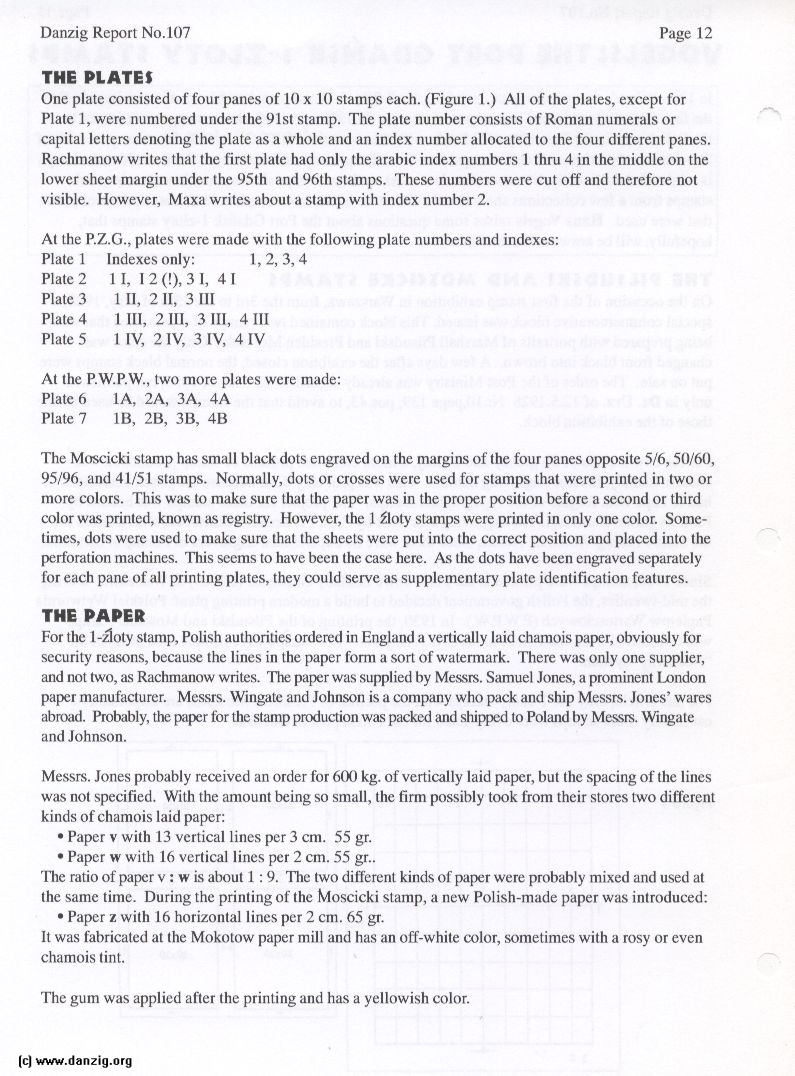
THE PLATES
One plate consisted of four panes of 10 x 10 stamps each. (Figure 1.) All of the plates, except for Plate 1, were numbered under the 91st stamp. The plate number consists of Roman numerals or capital letters denoting the plate as a whole and an index number allocated to the four different panes. Rachmanow writes that the first plate had only the arabic index numbers 1 thru 4 in the middle on the lower sheet margin under the 95th and 96th stamps. These numbers were cut off and therefore not visible. However, Maxa writes about a stamp with index number 2.
Al the P.Z.G., plates were made with the following plate numbers and indexes:
Plate 1 Indexes only: 1,2,3,4
Plate 2 II, 12(!),3I, 4I
Plate 3 1 II. 2 II, 3 III
Plate 4 1 II, 2 III, 3 III, 4 III
Plate 5 1 IV, 2 IV, 3 IV, 4 IV
At the P.W.P.W., two more plates were made:
Plate 6 1A, 2A, 3A, 4A
Plate 7 1B. 2B, 3B, 4B
The Moscicki stamp has small bbck dots engraved on the margins of the four panes opposite 5/6, 50/60, 95/96, and 4 1/51 stamps. Normally, dots or crosses were used for stamps that were printed in two or more colors. This was to make sure that the paper was in the proper position before a second or third color was printed, known as registry. However, the I loty stamps were printed in only one color. Somet imes, dots were used to make sure that the sheets were put into the correct position and placed into the perforation machines. This seems to have been the case here. As the dots have been engraved separately for each pane of all printing plates, they could serve as supplementary plate identification features.
THE PAPER
For the I -iioty stamp. Polish authorities ordered in England a vertically laid chamois paper, obviously for security reasons, because the lines in the paper fi)rm a sort of watermark. There was only one supplier, and not two, as Rachmanow writes. The paper was supplied by Messrs. Samuel Jones, a prominent London paper manufacturer. Messrs. Wingate and Johnson is a company who pack and ship Messrs. Jones’ wares abroad. Probably, the paper Ibr the stamp production was packed and shipped to Poland by Messrs. Wmgate and Johnson.
Messrs. Jones probably received an order for 600 kg. of vertically laid paper, but the spacing of the lines was not specified. With the amount being so small, the firm possibly took from their stores two different kinds of chamois laid paper:
• Paper v with 13 vertical lines per 3 cm. 55 gr.
• Paper w with 16 vertical lines per 2 cm. 55 gr..
The ratio of paper v: w is about 1:9. The two different kinds of paper were probably mixed and used at the same time. During the printing of the Moscicki stamp. a new Polish-made paper was introduced:
• Paper z wiih 16 horizontal lines per 2 cm. 65 gr.
It was fabricated at the Mokotow paper mill and has an off-white color, sometimes with a rosy or even chamois tint.
The gum was applicd after the printing and has a yellowish color.
Danzig Report Vol. 1 - Nr. 107 - April - May - June - 2000, Page 13.
Hits: 3284
Added: 28/07/2015
Copyright: 2025 Danzig.org

